2014 FORD F150 air condition
[x] Cancel search: air conditionPage 9 of 41
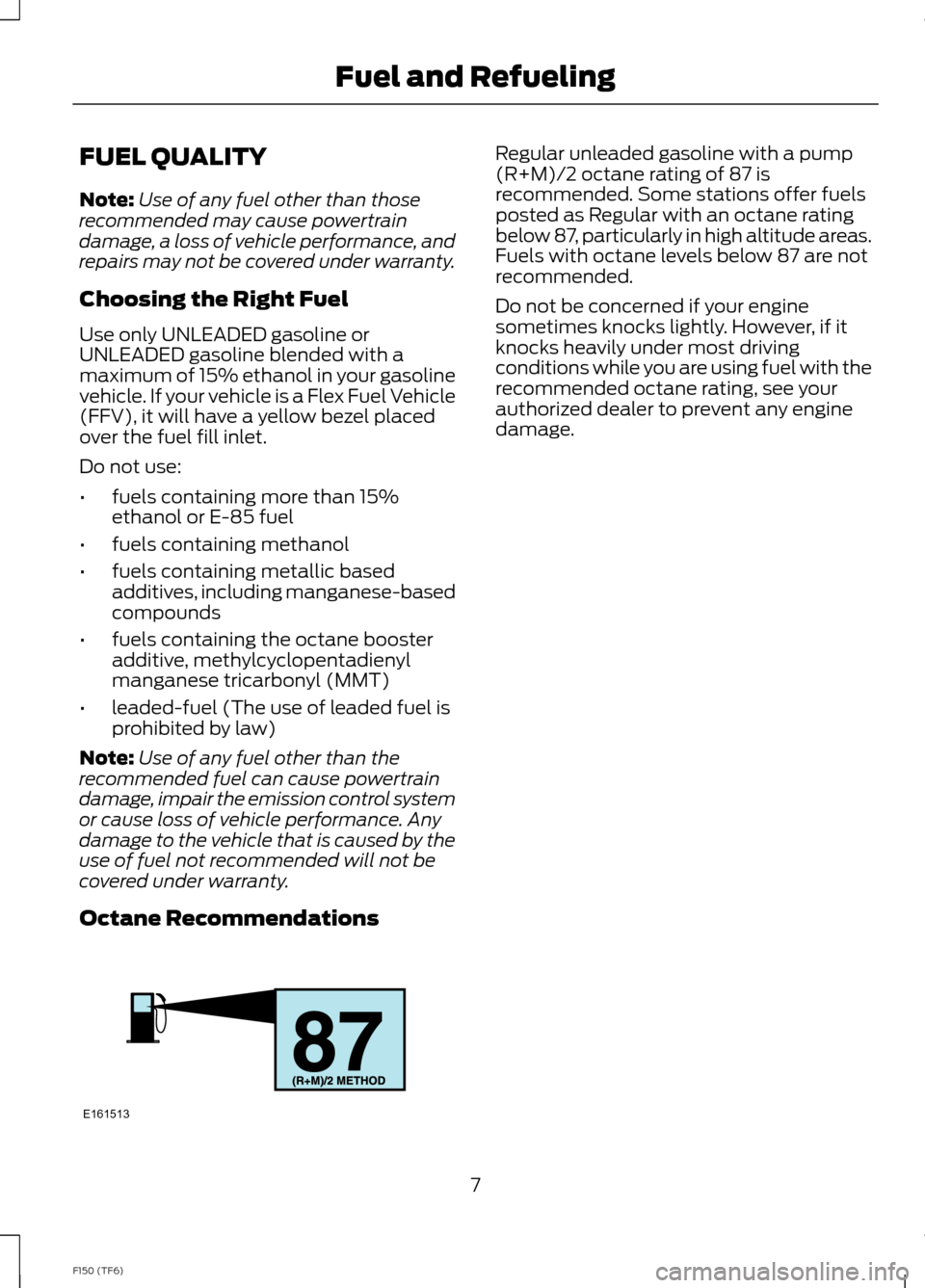
FUEL QUALITY
Note:Use of any fuel other than thoserecommended may cause powertraindamage, a loss of vehicle performance, andrepairs may not be covered under warranty.
Choosing the Right Fuel
Use only UNLEADED gasoline orUNLEADED gasoline blended with amaximum of 15% ethanol in your gasolinevehicle. If your vehicle is a Flex Fuel Vehicle(FFV), it will have a yellow bezel placedover the fuel fill inlet.
Do not use:
•fuels containing more than 15%ethanol or E-85 fuel
•fuels containing methanol
•fuels containing metallic basedadditives, including manganese-basedcompounds
•fuels containing the octane boosteradditive, methylcyclopentadienylmanganese tricarbonyl (MMT)
•leaded-fuel (The use of leaded fuel isprohibited by law)
Note:Use of any fuel other than therecommended fuel can cause powertraindamage, impair the emission control systemor cause loss of vehicle performance. Anydamage to the vehicle that is caused by theuse of fuel not recommended will not becovered under warranty.
Octane Recommendations
Regular unleaded gasoline with a pump(R+M)/2 octane rating of 87 isrecommended. Some stations offer fuelsposted as Regular with an octane ratingbelow 87, particularly in high altitude areas.Fuels with octane levels below 87 are notrecommended.
Do not be concerned if your enginesometimes knocks lightly. However, if itknocks heavily under most drivingconditions while you are using fuel with therecommended octane rating, see yourauthorized dealer to prevent any enginedamage.
7F150 (TF6)Fuel and RefuelingE161513
Page 15 of 41
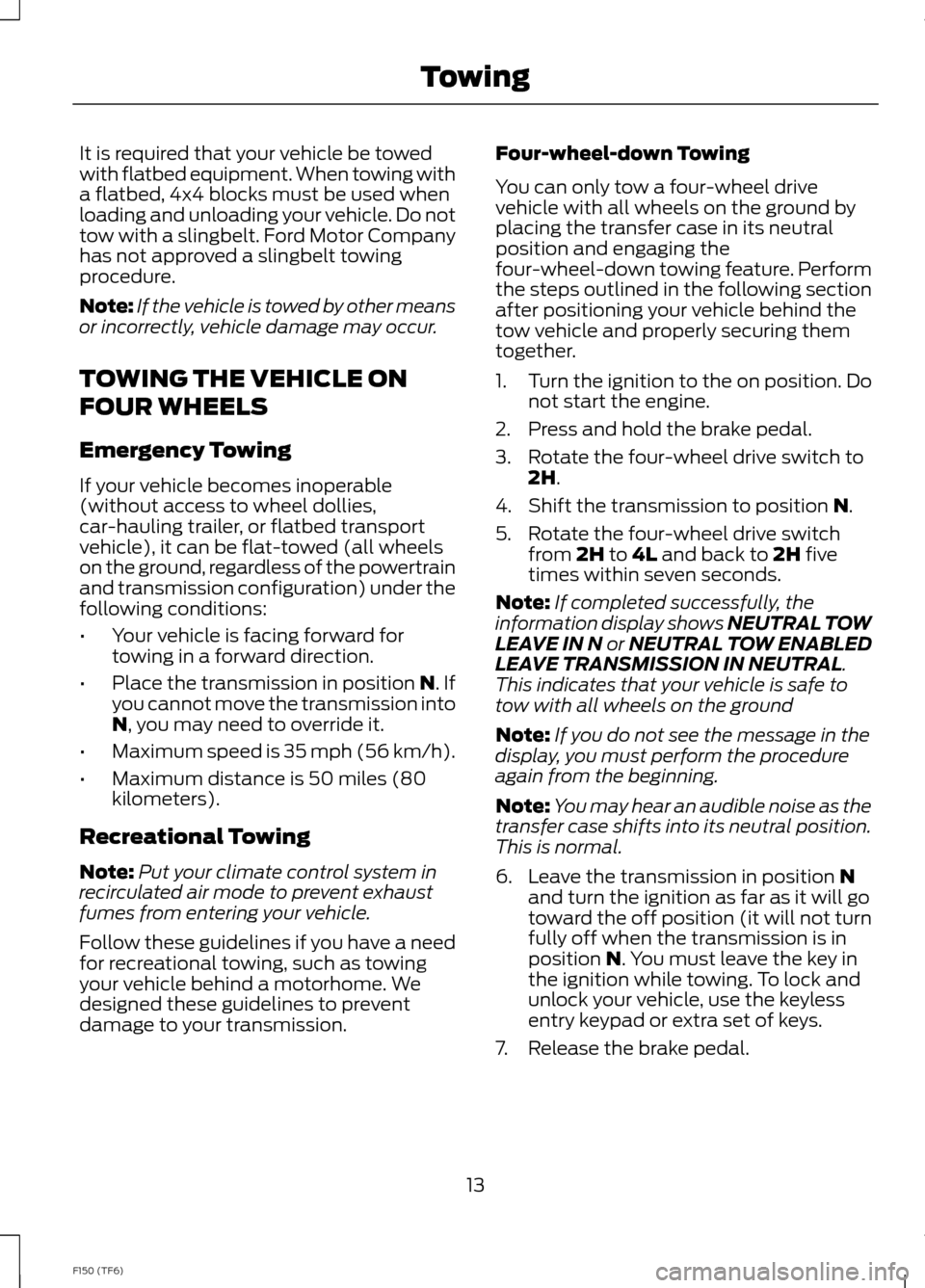
It is required that your vehicle be towedwith flatbed equipment. When towing witha flatbed, 4x4 blocks must be used whenloading and unloading your vehicle. Do nottow with a slingbelt. Ford Motor Companyhas not approved a slingbelt towingprocedure.
Note:If the vehicle is towed by other meansor incorrectly, vehicle damage may occur.
TOWING THE VEHICLE ON
FOUR WHEELS
Emergency Towing
If your vehicle becomes inoperable(without access to wheel dollies,car-hauling trailer, or flatbed transportvehicle), it can be flat-towed (all wheelson the ground, regardless of the powertrainand transmission configuration) under thefollowing conditions:
•Your vehicle is facing forward fortowing in a forward direction.
•Place the transmission in position N. Ifyou cannot move the transmission intoN, you may need to override it.
•Maximum speed is 35 mph (56 km/h).
•Maximum distance is 50 miles (80kilometers).
Recreational Towing
Note:Put your climate control system inrecirculated air mode to prevent exhaustfumes from entering your vehicle.
Follow these guidelines if you have a needfor recreational towing, such as towingyour vehicle behind a motorhome. Wedesigned these guidelines to preventdamage to your transmission.
Four-wheel-down Towing
You can only tow a four-wheel drivevehicle with all wheels on the ground byplacing the transfer case in its neutralposition and engaging thefour-wheel-down towing feature. Performthe steps outlined in the following sectionafter positioning your vehicle behind thetow vehicle and properly securing themtogether.
1.Turn the ignition to the on position. Donot start the engine.
2.Press and hold the brake pedal.
3.Rotate the four-wheel drive switch to2H.
4.Shift the transmission to position N.
5.Rotate the four-wheel drive switchfrom 2H to 4L and back to 2H fivetimes within seven seconds.
Note:If completed successfully, theinformation display shows NEUTRAL TOWLEAVE IN N or NEUTRAL TOW ENABLEDLEAVE TRANSMISSION IN NEUTRAL.This indicates that your vehicle is safe totow with all wheels on the ground
Note:If you do not see the message in thedisplay, you must perform the procedureagain from the beginning.
Note:You may hear an audible noise as thetransfer case shifts into its neutral position.This is normal.
6.Leave the transmission in position Nand turn the ignition as far as it will gotoward the off position (it will not turnfully off when the transmission is inposition N. You must leave the key inthe ignition while towing. To lock andunlock your vehicle, use the keylessentry keypad or extra set of keys.
7.Release the brake pedal.
13F150 (TF6)Towing
Page 22 of 41
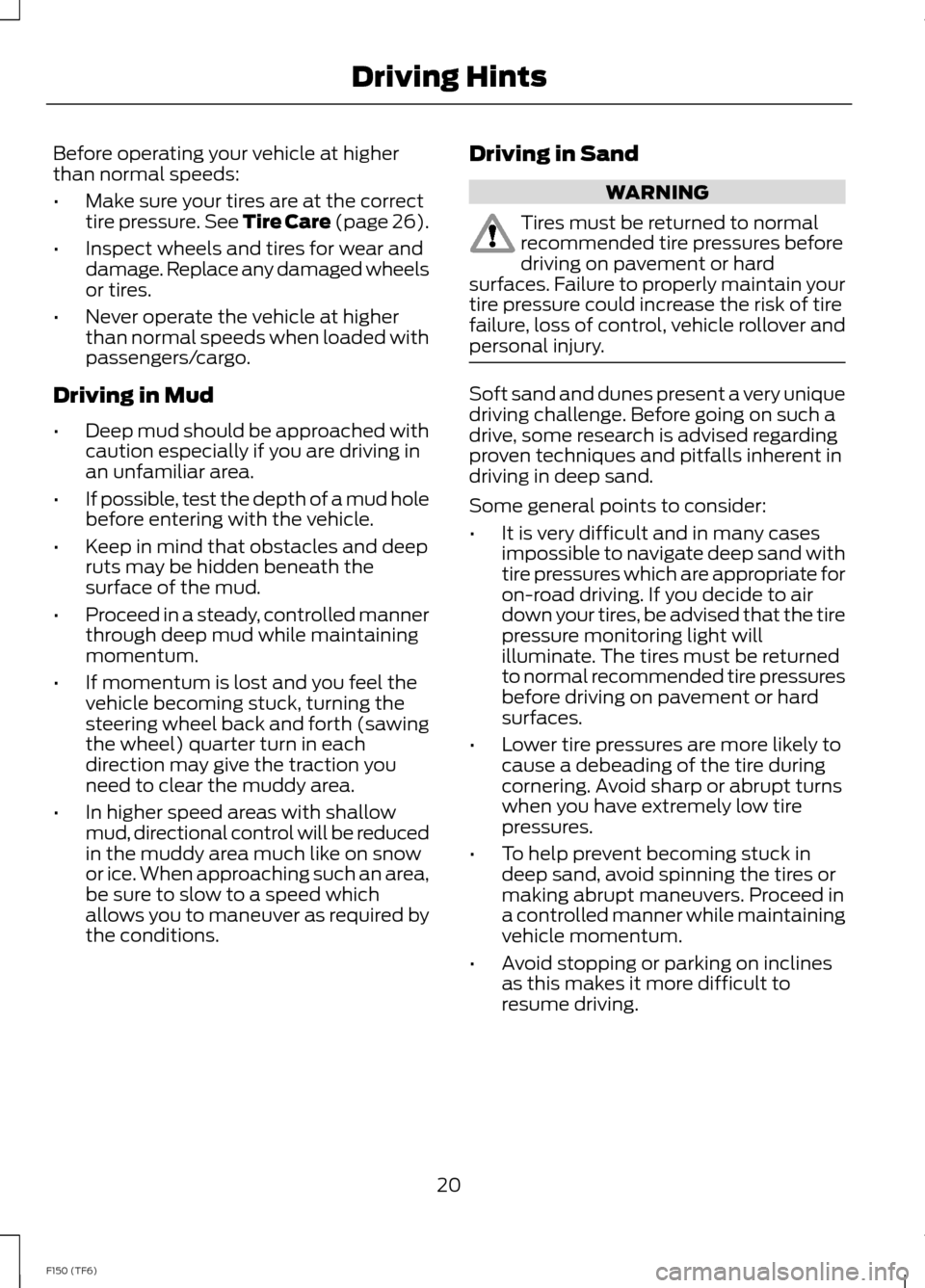
Before operating your vehicle at higherthan normal speeds:
•Make sure your tires are at the correcttire pressure. See Tire Care (page 26).
•Inspect wheels and tires for wear anddamage. Replace any damaged wheelsor tires.
•Never operate the vehicle at higherthan normal speeds when loaded withpassengers/cargo.
Driving in Mud
•Deep mud should be approached withcaution especially if you are driving inan unfamiliar area.
•If possible, test the depth of a mud holebefore entering with the vehicle.
•Keep in mind that obstacles and deepruts may be hidden beneath thesurface of the mud.
•Proceed in a steady, controlled mannerthrough deep mud while maintainingmomentum.
•If momentum is lost and you feel thevehicle becoming stuck, turning thesteering wheel back and forth (sawingthe wheel) quarter turn in eachdirection may give the traction youneed to clear the muddy area.
•In higher speed areas with shallowmud, directional control will be reducedin the muddy area much like on snowor ice. When approaching such an area,be sure to slow to a speed whichallows you to maneuver as required bythe conditions.
Driving in Sand
WARNING
Tires must be returned to normalrecommended tire pressures beforedriving on pavement or hardsurfaces. Failure to properly maintain yourtire pressure could increase the risk of tirefailure, loss of control, vehicle rollover andpersonal injury.
Soft sand and dunes present a very uniquedriving challenge. Before going on such adrive, some research is advised regardingproven techniques and pitfalls inherent indriving in deep sand.
Some general points to consider:
•It is very difficult and in many casesimpossible to navigate deep sand withtire pressures which are appropriate foron-road driving. If you decide to airdown your tires, be advised that the tirepressure monitoring light willilluminate. The tires must be returnedto normal recommended tire pressuresbefore driving on pavement or hardsurfaces.
•Lower tire pressures are more likely tocause a debeading of the tire duringcornering. Avoid sharp or abrupt turnswhen you have extremely low tirepressures.
•To help prevent becoming stuck indeep sand, avoid spinning the tires ormaking abrupt maneuvers. Proceed ina controlled manner while maintainingvehicle momentum.
•Avoid stopping or parking on inclinesas this makes it more difficult toresume driving.
20F150 (TF6)Driving Hints
Page 26 of 41
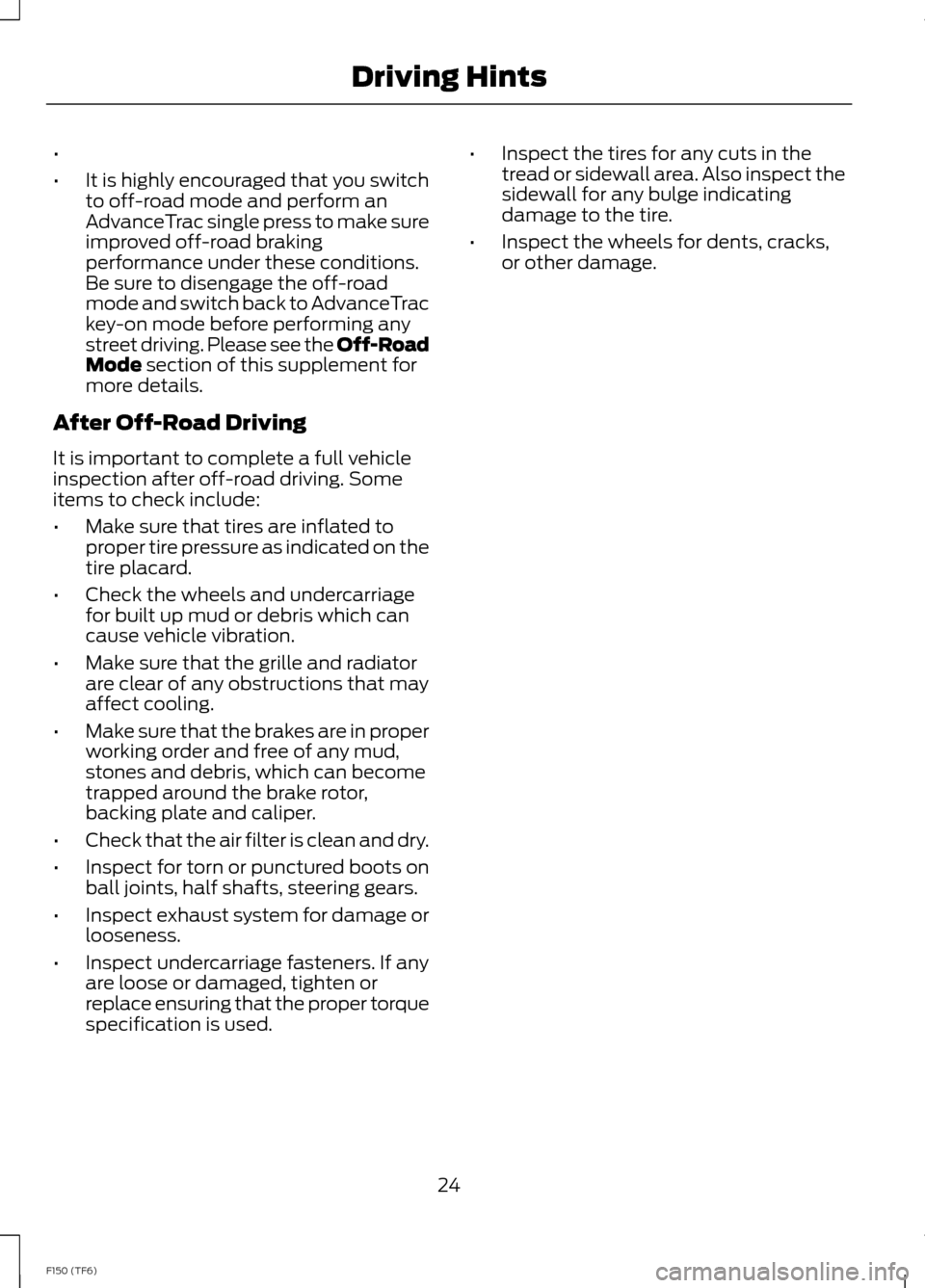
•
•It is highly encouraged that you switchto off-road mode and perform anAdvanceTrac single press to make sureimproved off-road brakingperformance under these conditions.Be sure to disengage the off-roadmode and switch back to AdvanceTrackey-on mode before performing anystreet driving. Please see the Off-RoadMode section of this supplement formore details.
After Off-Road Driving
It is important to complete a full vehicleinspection after off-road driving. Someitems to check include:
•Make sure that tires are inflated toproper tire pressure as indicated on thetire placard.
•Check the wheels and undercarriagefor built up mud or debris which cancause vehicle vibration.
•Make sure that the grille and radiatorare clear of any obstructions that mayaffect cooling.
•Make sure that the brakes are in properworking order and free of any mud,stones and debris, which can becometrapped around the brake rotor,backing plate and caliper.
•Check that the air filter is clean and dry.
•Inspect for torn or punctured boots onball joints, half shafts, steering gears.
•Inspect exhaust system for damage orlooseness.
•Inspect undercarriage fasteners. If anyare loose or damaged, tighten orreplace ensuring that the proper torquespecification is used.
•Inspect the tires for any cuts in thetread or sidewall area. Also inspect thesidewall for any bulge indicatingdamage to the tire.
•Inspect the wheels for dents, cracks,or other damage.
24F150 (TF6)Driving Hints
Page 37 of 41
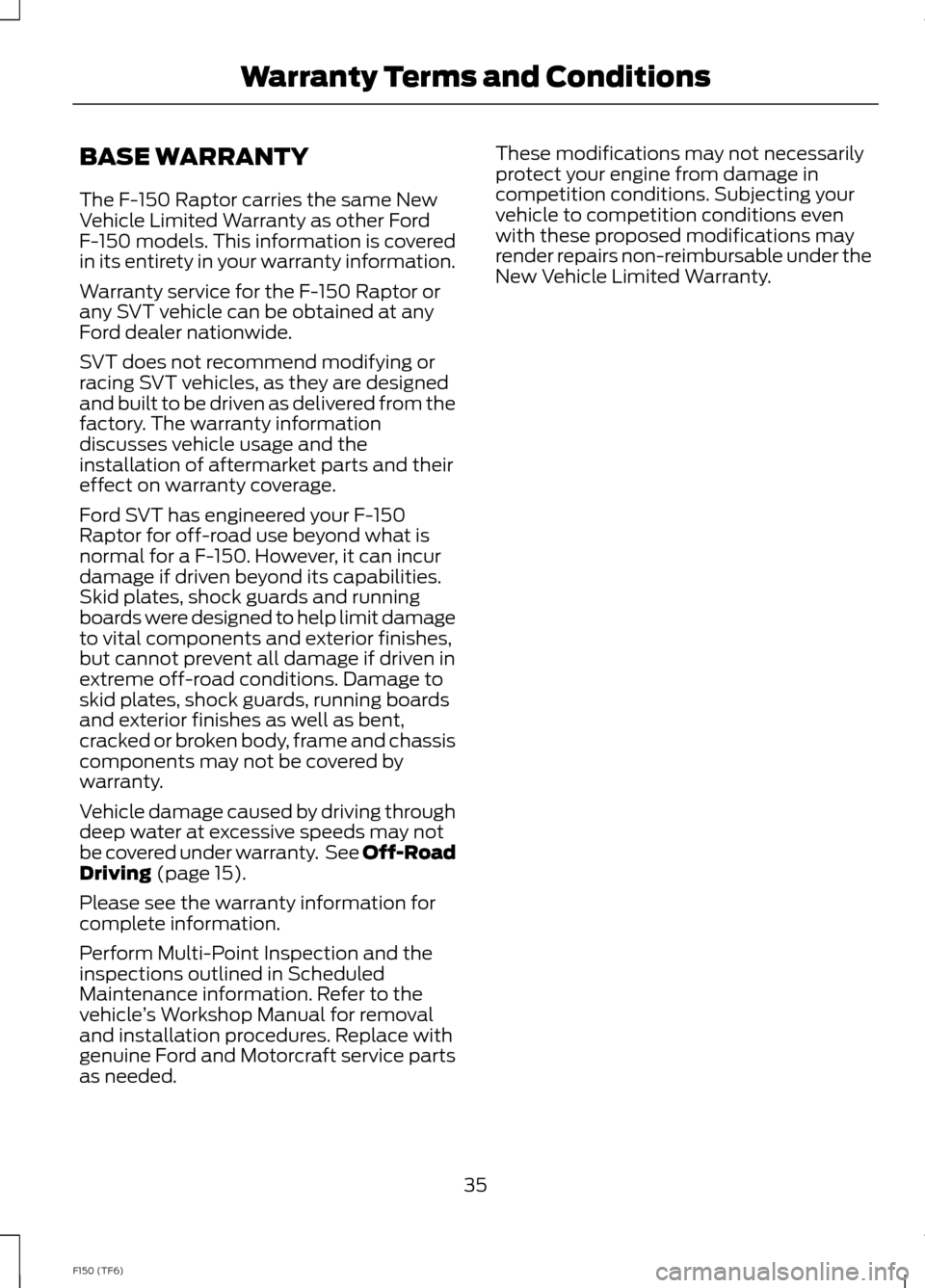
BASE WARRANTY
The F-150 Raptor carries the same NewVehicle Limited Warranty as other FordF-150 models. This information is coveredin its entirety in your warranty information.
Warranty service for the F-150 Raptor orany SVT vehicle can be obtained at anyFord dealer nationwide.
SVT does not recommend modifying orracing SVT vehicles, as they are designedand built to be driven as delivered from thefactory. The warranty informationdiscusses vehicle usage and theinstallation of aftermarket parts and theireffect on warranty coverage.
Ford SVT has engineered your F-150Raptor for off-road use beyond what isnormal for a F-150. However, it can incurdamage if driven beyond its capabilities.Skid plates, shock guards and runningboards were designed to help limit damageto vital components and exterior finishes,but cannot prevent all damage if driven inextreme off-road conditions. Damage toskid plates, shock guards, running boardsand exterior finishes as well as bent,cracked or broken body, frame and chassiscomponents may not be covered bywarranty.
Vehicle damage caused by driving throughdeep water at excessive speeds may notbe covered under warranty. See Off-RoadDriving (page 15).
Please see the warranty information forcomplete information.
Perform Multi-Point Inspection and theinspections outlined in ScheduledMaintenance information. Refer to thevehicle’s Workshop Manual for removaland installation procedures. Replace withgenuine Ford and Motorcraft service partsas needed.
These modifications may not necessarilyprotect your engine from damage incompetition conditions. Subjecting yourvehicle to competition conditions evenwith these proposed modifications mayrender repairs non-reimbursable under theNew Vehicle Limited Warranty.
35F150 (TF6)Warranty Terms and Conditions